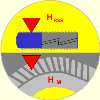 1. Difference in hardness: HRSS > Hmaterial
1. Difference in hardness: HRSS > Hmaterial
The ring lock washer has a higher surface hardness than commercially
obtainable bolts including high grade bolts up to quality 12.9.
When tightening the bolt, the serration on the mating outer side
of the washer grips. The result is a positive locking of the washer
with the surface of the jointed parts.
|
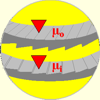 2. Difference in friction: µo > µi
2. Difference in friction: µo > µi
The smooth wedge-shaped segments on the dividing plane of the both
halfs of the washer naturally have a considerable lower friction
coefficient µi than the serrated
outer surface µo.
A loose rotation caused by dynamic load leads inevitably to a movement
between the two halfs of the washer.
|
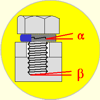 3. Difference in angles: α > β
3. Difference in angles: α > β
The angle of the wedges α on the dividing
plane of the both halfs of the washer is greater than the lead of
the thread β.
Due to this difference in angles the dilatation of the ring
lock washer is greater than the axial displacement of the bolt.
|
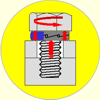 4. Difference in pre-load: Fdyn > Fstat
4. Difference in pre-load: Fdyn > Fstat
The extention in thickness of the ring lock washer, caused by
loose rotation, leads to an elongation of the bolt.
This effect leads directly to an increase of the pre-load compared
with the quiescent state and as a result of this the desired self-locking
effect happens.
|
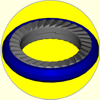 5. Difference in comfort:
5. Difference in comfort:
Whereas other bipartite washers are assembled separately or at best
are glued provisionally, the two halfs of the ring lock washer
are united undetachably by a high-quality plastics ring.
So there can never be a wrong and thereby ineffective assembly of
the washer, nor by reuse.
|
|

